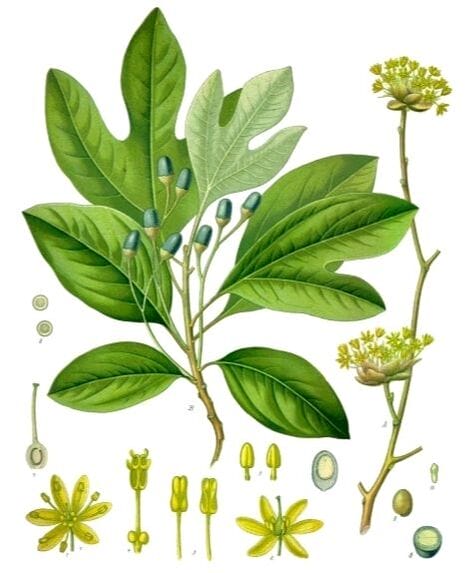Sassafras |

|

|
 S. albidum
S. albidumMedizinal-Pflanzen, Köhler, 1897
Botanical name:
Sassafras albidum (syn. Laurus sassafras), S. officinale
Parts used:
Root bark; Wood
Temperature & Taste:
Warm, dry. Bitter, Pungent. Slightly Toxic
Classifications:
2B ATTENUATERS
3A. SUDORIFICS & DIAPHORETICS. 3M. ARTHRITICS
4k. ARTHRITIC
Uses:
1. Clears Heat and Damp, Resists Poison:
-good for all Catarrhs for which it is a ‘Panacea or Universal Remedy’. (Schroder)
-promotes Sweat
-Syphilis and Venereal Disease as a diet drink
2. Clears Wind-Damp, Opens Obstructions:
-Arthritis, Rheumatism
-Tumors; auxiliary in Cancer treatment
-’helps in most diseases proceeding from obstructions’. (Salmon)
3. Strengthens Kidneys, Benefits Qi:
-’it strengthens the whole body, and cures Barrenness’.
4. Flavoring:
–used as a flavor, including in ‘Root beer’
Dose:
1. It is destroyed by long boiling. Add towards the end of decocting.
2. The leaf can be used in similar doses.
LONG INFUSION or BRIEF DECOCTION: 2–4 grams, twice daily;
FLUID EXTRACT (1:1 in 25%): 2–4 mls.;
POWDER: 500mg–1 gram.
The oil has been taken internally in doses of 1–3, or 4 drops on sugar, but it is too toxic to permit this today.
Substitute:
The bark of the Australian Atherosperma moschatum (‘Southern Sassafras’) is used similarly.
Main Combinations:
Sassafras is often combined with Sarsaparilla, China root, Guaiacum etc.
1. Skin diseases, Sassafras with Walnut leaf, Senna leaf, Guaiacum, Couch grass (Ulrich)
2. To promote Sweat in Cold, Flu, Catarrh, Syphilis, Edema etc., Sassafras with Sarsaparilla, China root, Elder flower, Cassia wood (as in Sudorific Vinegar)
3. To cleanse the Blood:
i. ‘Dutch Blood Purifier’: Sassafras with Sage, Sarsaparilla, Pennyroyal, Figs
ii. Sassafras, Sarsaparilla, Burdock, Guaiacum
4. Syphilis:
i. Sassafras with Sarsaparilla, Guaiacum, Restharrow, Licorice
ii. Sassafras with Sarsaparilla, Guaiacum, China root (as in Decoction of Woods)
5. Catarrh, Gout, Pruritus, Sassafras with Sage, Nutmeg, Cinnamon, Star Anise
6. Cold Rheumatic diseases of the Head and Nerves, Sassafras with Guaiacum, Peony, Sage, Betony
7. Rheumatism:
i. Sassafras with Blue Flag root
ii. Sassafras, Sarsaparilla, Licorice root (2 parts each), Cassis wood, Calamus (1 part each).
iii. Rheumatic Liniment: Oil of Sassafras (6 fl. oz.), Oil of Origanum (4 fl. oz.), Oil of Cedar (2 fl. oz.), Oil of Amber (1 fl. oz.), Camphor (8 oz.), Oil of Turpentine, sufficient to make a gallon.
Major Formulas:
Troches of Agnus Castus
Decoction of Woods
Wine for Edema
Sudorific Vinegar
Cautions:
1. Due to the large levels of Safrole, it has been recommended to avoid use of Sassafras internally. If it is used internally, dosage should not be increased, and a break after 2 or 3 weeks of treatment should be taken.
2. Not used during Pregnancy, Breastfeeding, or in children under 12 years of age.
3. Reportedly hallucinogenic.
Toxicity:
Safrole, the major ingredient is neurotoxic, nephrotoxic, hepatotoxic, and carcinogenic in animals. Safrole-free extracts are said to be largely pharmacologically inactive, but have reportedly still caused tumors in animal experiments. Black Pepper also contains Safrole, though in very low doses.
Symptoms of toxicity include Ataxia, Depression, Diarrhea, potentially leading to death in 4 hours to 7 days. Rats fed 0.25% Safrole in their diet experienced growth retardation, liver necrosis, hepatoma, and atrophy of the stomach and testes.
It has been stated that one cup of Sassfras tea may contain up to 5 times the amount of Safrole that conservative estimates consider safe. However, Duke points out that Bruce Ame’s Herb Index suggests that Sassafras tea for its Safrole content is one-thirteenth as carcinogenic as beer is for its ethanol.
LD50 of Safrole is 1950mg/kg in rats, 2350mg/kg in mice
Main Preparations used:
An Extract and a Distilled Oil were used
